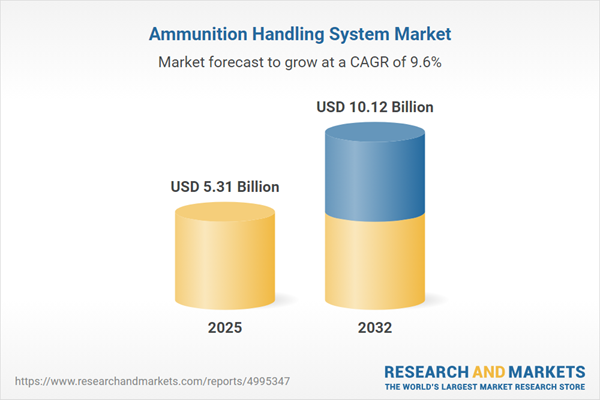Speak directly to the analyst to clarify any post sales queries you may have.
The ammunition handling system market is evolving rapidly as defense organizations seek higher efficiency, security, and operational responsiveness in an environment shaped by changing mission requirements and regulatory expectations. Advanced automation and flexible system architectures have become integral to supporting modern defense strategies and driving sector advancement.
Market Snapshot: Ammunition Handling System Market and Competitive Dynamics
The global ammunition handling system market is experiencing consistent growth, influenced by a heightened commitment to logistics automation and next-generation system integration. Industry participants are adopting new technologies and digital tools to strengthen their competitive edge, expanding their reach across multiple regions. As regulatory frameworks continue to develop, market leaders are focusing on modular solutions and strategic partnerships with suppliers to maintain compliance and operational flexibility. Organizations that emphasize innovation and scalable modernization demonstrate greater capability to meet diverse regional defense needs and evolving mission profiles in a competitive landscape.
Scope & Segmentation
This research provides actionable intelligence for senior defense executives focused on elevating their ammunition handling strategies. The analysis outlines the technology trends, procurement factors, and operational applications shaping future market direction and immediate investment priorities.
- Component Types: Feeder units, loader devices, belts, drums, and magazine storage systems collectively enhance operational workflows, secure ammunition transfer, and enable comprehensive management across all stages of system use.
- System Types: Automated, semi-automated, and manual systems—including sophisticated conveyor mechanisms and integrated robotics—provide adaptable pathways for modernization tailored to varying mission scenarios and deployment requirements.
- Platform Integration: Flexible solutions support seamless deployment on land, air, and naval assets, equipping defense operations to swiftly address changing mission conditions and optimize force mobilization.
- Mount Configurations: Both mobile and fixed options address requirements for permanent infrastructure as well as temporary, mission-focused deployments across different operational environments.
- End User Profiles: System configurations align with the logistics needs of land, air, and naval forces, in addition to specialized commercial defense users, ensuring compliance with local regulations and operational objectives.
- Applications: The systems enable a broad range of uses, from direct combat support and simulated training to equipment testing, advancing mission readiness and flexible response capabilities.
- Regional Coverage: The analysis spans the Americas, Europe, Middle East & Africa, and Asia-Pacific, highlighting how procurement criteria and compliance shape vendor strategies within major defense markets.
- Leading Companies: BAE Systems plc, General Dynamics Corporation, Rheinmetall AG, Lockheed Martin Corporation, Oshkosh Defense, Hanwha Defense, Thales S.A., Leonardo S.p.A., Kongsberg Defence & Aerospace, and Textron Systems Corporation serve as key benchmarks for innovation and quality within the sector.
Key Takeaways: Strategic Insights and Competitive Approaches
- Technological advances—including digitization and robotics—are driving transparency in ammunition logistics, supporting better procurement decisions and more secure mission execution for defense organizations.
- Modular system designs allow for rapid reconfiguration, reducing operational complexity and supporting efficient upgrades as mission demands evolve.
- Cybersecurity is now a critical element embedded in logistics and supply chain operations, strengthening both information and asset protection throughout system lifecycles.
- Collaborative alliances with suppliers and technology providers accelerate innovation while supporting compliance across diverse regulatory regimes.
- Flexible procurement approaches that prioritize agility enable the adoption of new technologies and compliance with region-specific policies and standards.
- Advanced risk management and supply chain mapping are essential for sustaining system reliability in a dynamic global defense market.
Tariff Impact: Navigating Changing Regulatory Landscapes
- Recent tariff revisions in the United States have prompted heightened domestic sourcing, strengthening supply chain security and supporting commitments within global defense programs.
- Formal collaborations and joint ventures foster adaptability, equipping organizations to address emerging regulatory shifts in the worldwide defense landscape.
- Diversified supplier networks and disciplined risk strategies help ensure reliable and scalable delivery of ammunition handling systems across both regional and international jurisdictions.
Research Methodology & Data Sources
Findings in this report are informed by executive interviews with leaders in procurement and operations, technical documentation reviews, industry white paper assessments, and close monitoring of global patent activity. Scenario modeling and data triangulation from public and proprietary sources underpin the reliability of insights provided.
Why This Report Matters
- Enables defense executives to guide effective procurement and strategic modernization of ammunition handling systems in complex environments.
- Aligns organizational acquisition strategies with rapidly changing regulatory demands and regional requirements.
- Offers practical guidance for advancing technology adoption, managing operational risk, and building resilient industry partnerships.
Conclusion
As operational and compliance requirements become more complex, prioritizing automated and modular ammunition handling systems empowers defense organizations to enhance agility, ensure resilience, and maintain mission readiness across global deployments.
Additional Product Information:
- Purchase of this report includes 1 year online access with quarterly updates.
- This report can be updated on request. Please contact our Customer Experience team using the Ask a Question widget on our website.
Table of Contents
3. Executive Summary
4. Market Overview
7. Cumulative Impact of Artificial Intelligence 2025
Companies Mentioned
The companies profiled in this Ammunition Handling System market report include:- BAE Systems PLC
- General Dynamics Corporation
- Rheinmetall AG
- Lockheed Martin Corporation
- Oshkosh Defense, LLC
- Hanwha Defense Corporation
- Thales S.A.
- Leonardo S.p.A
- Kongsberg Defence & Aerospace AS
- Textron Systems Corporation
Table Information
| Report Attribute | Details |
|---|---|
| No. of Pages | 181 |
| Published | November 2025 |
| Forecast Period | 2025 - 2032 |
| Estimated Market Value ( USD | $ 5.31 Billion |
| Forecasted Market Value ( USD | $ 10.12 Billion |
| Compound Annual Growth Rate | 9.6% |
| Regions Covered | Global |
| No. of Companies Mentioned | 11 |









